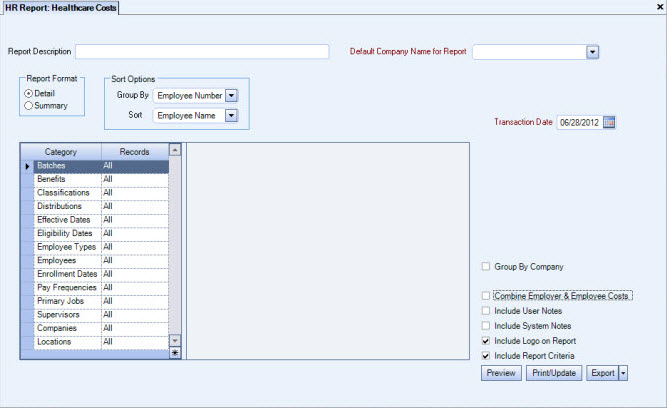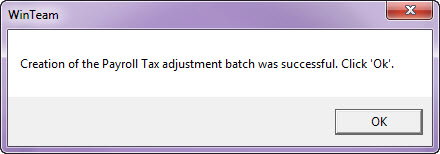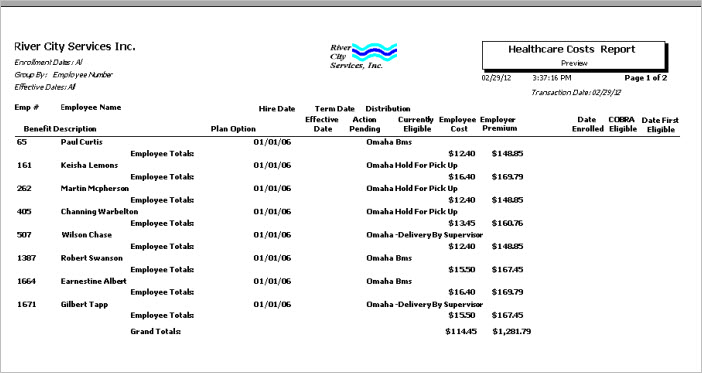Overview
For benefits managed in WinTeam's Human Resources module, you can use the Human Resources Healthcare Costs report to review the total cost of employer-sponsored insurance, which is reported on Employee Form W-2 Box 12. The Patient Protection and Affordable Care Act also requires that employers report the cost of coverage under an employer-sponsored group health plan. The purpose of the reporting requirement is to inform employees about the cost of their health coverage; reporting healthcare coverage costs does not make coverage taxable to the employee.
The amount reported should include the total premium paid by the employer. This includes both employee contribution amounts and the employer's portion of healthcare costs .This amount is what is shown in the ER Premium column and is typically a monthly premium amount. This report can then be used to make monthly tax adjustments to the Special W-2 Description Employee Sponsored Healthcare.
If you do not have Benefits set up in the Human Resources module, you can manually track Employer Sponsored Healthcare Coverage amounts, and then create a Tax Adjustment at the end of the year in order to report the appropriate amounts in Box 12 of the Form W-2.
In HR: Benefit Setup, the Include on W2 as Employer Sponsored Health Coverage check box is available for benefit methods of Insurance/Other. The Healthcare Costs Report includes the health care costs set up and paid by employers. Costs can be displayed by the employer (ER), the employee (EE), or combined, and used for tracking purposes and tax reporting. Only Benefits set up with Include on W2 as Employer Sponsored Health Coverage selected will display in the Benefits list on this report.

Key Functionality
Type a description to name the report. This description prints above the Report Title.
Available for Clients using the Multi-Company feature. The Default Company Name for Report is populated from the Company Setup screen. The list contains all companies you have permission to access.
- If the User has permission to only one company, then just that one company will display in the list.
- If the User has permissions to more than one company, the list will contain all companies the User has rights to PLUS the default reporting company.
When the Group By Company option is selected, the default company prints on the Grand Total Page and the Report Criteria page. All other pages print the applicable company name. When the Group By Company option is NOT selected, the default company prints on every page of the report.
For more information see Learning about WinTeam Reports.
Use the Report Format option to choose the level of detail for the report.
The Summary report displays the Healthcare amounts for both the Employee Cost (per pay period) and the Employer Premium per month.
The Detail report includes a breakout by each Plan Option.
Select to Group By Employee Number, Employee Type, Classification, Distribution, Supervisor, Pay Frequency, Primary Job, Benefit, Benefit Plan Option, or Employee. The default is Employee Number.
Select to Sort by Employee Name, Effective Date, Employee Number, or Benefit Type. The default is Employee Name.
The Transaction Date defaults to today's date. However, the date can be modified.
The Transaction Date field stamps the Print/Update function so when exporting data to a Payroll Tax adjustment batch, this date will be the batch date for the transactions.
Batches
Use the Batches category to select the Batches to include on the report.
Select All to include all Benefits on the report.
Select Pick to define specific Batches for the report. When you select Pick, the Batches list displays. Select the check box next to each Batch to include on the report.
Benefits
Use the Benefits category to select the Benefits to include on the report.
Select All to include all Benefits on the report.
Select Pick to define specific Benefits for the report. When you select Pick, the Benefits list displays. Select the check box next to each Benefit to include on the report.
Example: Only the Benefits set up in HR: Benefit Setup with the Include on W2 as Employer Sponsored Health Coverage check box selected display in the Benefits list.
Classifications
Use the Classifications category to select the Classifications to include on the report.
Select All to include all Classifications.
Select Pick to define specific Classifications for the report. When you select Pick, the Classifications list displays. Select the check box next to each Classification to include on the report.
Distributions
Use the Distributions category to select the Distribution to include.
Select All to include all Distribution types.
Select Pick to define specific Distribution to include. When you select Pick, the Check Distributions add edit list displays. Select the check box next to each Check Distribution to include.
Effective Dates
Use the Effective Dates category to select the dates to include on the report.
Select All to include all Effective Dates.
Select Date Range to define a range of Effective Dates for the report. When you select Date Range, the range fields display. Type the beginning date in the From field and the ending date in the To field.
Eligibility Dates
Use the Eligibility Dates category to select the dates to include on the report.
Select All to include all Eligibility Dates.
Select Date Range to define a range of Eligibility Dates for the report. When you select Date Range, the range fields display. Type the beginning date in the From field and the ending date in the To field.
Employee Types
Use the Employee Types category to select the Employee Types to include.
Select All to include all Employee Types.
Select Pick to define specific Employee Types. When you select Pick, the Employee Types list displays. Select the check box next to each Employee Type to include.
Employees
Use the Employees category to select the Employees to include on the report.
Select All to include all Employees on the report.
Select Range to define a range of Employees for the report. Type the beginning Employee Number in the From field and the ending Employee Number in the To field.
Select Create to define your own list of Employees. When you select Create, a small grid displays to the right. Enter the Employee Numbers you want to include in the list, or use the Lookup to locate the Employee Numbers.
Select Exclude to identify records that should not be included. When you select Exclude, a small grid displays to the right. Enter the Employee Numbers you want to exclude in the list, or use the Lookup to locate the Employee Numbers.
Enrollment Dates
Use the Enrollment Dates category to select the dates to include on the report.
Select All to include all Enrollment Dates.
Select Date Range to define a range of Enrollment Dates for the report. When you select Date Range, the range fields display. Type the beginning date in the From field and the ending date in the To field.
Pay Frequencies
Select the Pay Frequencies to include on the report.
If using the Pick from List option, the system determines the check records to include by the Employee's current Pay Frequency set up in the Employee Master File. The only exception is when running the report for Format: Report and Report Type: Detail by Check.
Note: When running the report for Format: Report and Report Type: Detail by Check and limiting the pay frequency using the Pay Frequencies category, the system will look at the pay frequency of the batch instead of the Employee's current pay frequency. All Batch Types have a Pay Frequency defined except for Void and Tax Adjustment Batches. For Void and Tax Adjustment batches, the current pay frequency of the Employee (as indicated in the Employee Master File) will determine whether the void or tax adjustment record is included.
Primary Jobs
Use Primary Jobs to filter the report by Primary Jobs.
Select All to include all Primary Jobs.
Select Range to define a range of Primary Jobs for the report. When you select Range, the range fields display. Type the beginning Primary Job Number in the From field and the ending Primary Job Number in the To field.
Select Pick to select the Primary Job(s) to include.
Select Create to define your own list of records. When you select Create, a small grid displays to the right. Enter the records you want to include in the list, or use the Lookup to locate the records.
Select Exclude to identify records that should not be included. When you select Exclude, a small grid displays to the right. Enter the records you want to exclude in the list, or use the Lookup to locate the records.
Supervisors
Use the Supervisors category to filter the report by Supervisors.
Select All to include all Supervisors.
Select Pick to select the Supervisor(s) to include.
Companies
The Company Pick option filters for AR Invoice and Payment records. The Companies category is available for Clients using the Multi-Company feature.
Select the Companies to include on the report.
Select All to include all companies on the report.
Select Pick to define specific Companies for the report. When you select Pick, the Companies list displays. Select the check box next to each Company to include on the report.
Note: When running reports using the Company Category/Record Pick and the company name exceeds the maximum number of characters, WinTeam will truncate the name.
Locations
The Locations category is available for Clients using the Multi-Location feature.
Use the Locations category to select the Locations to include on the report.
Select All to include all Locations on the report.
Select Pick to define specific Locations for the report. When you select Pick, the Locations list displays. Select the check box next to each Location to include on the report.
This option is available to users who have more than one company, but is not selected by default. If selected, the default company prints on the Grand Total Page and the Report Criteria page. All other pages print the applicable company name. If not selected, the default company prints on every page of the report.
This option is only available for those companies who have chosen to store their ER Premium as a pay period amount instead of a monthly amount, AND if the amount does not already include the employee's portion. In this case, the amount listed in the Combined Costs column on the report is the figure that should be reported.
If this option is not checked, then the amount in the ER Premium column is what should be reported.
When this option is selected, the Check Dates options display and are required in order to run the report. WinTeam will look back at Payroll Check Deductions for the Employee that are tied to the applicable benefits and total up the deduction amounts and use that total.
Select this check box to print the company logo on the report. It is selected or cleared by default based on the option selected in SYS:Defaults. However, you can modify the setting on each report.
Select this check box to include a list of the report options selected for the report. The Report Criteria page includes any ranges specified and each Category/Record selection made for the report. This check box is cleared selected by default.
Click the Preview button (or use the shortcut key, ALT + V) to view before printing.
Click to either print or create a tax adjustment batch using the Special W2 Description of Employer Sponsored Health Coverage. Normally, this is run on a regular basis, and should coincide with the amount represented in the ER Premium.
For example if your ER Premium is a monthly amount, then update/run monthly. If your ER Premium is a quarterly amount, then update/run quarterly. If your ER Premium is a pay period amount, then run every pay period.
Select No to print the report but not update transactions.

Select Yes to create a batch for the transactions, just as if you are making a Tax Adjustment in the Check Processing Wizard. The report is printed showing the items created in the tax adjustment batch.
For details on the tax adjustment see Printing and Updating Healthcare Costs.
When the update is complete, you will see this message:

Click (or press ALT + X) to export the report to a specified format.
Reports may be exported to Adobe Acrobat (PDF), Excel, Comma-Separated Values (CSV), Grid View and E-mail (available for premise-based clients only).
Related Information
The HR Report Healthcare Costs screen does not have its own Security Group.
The HR Report Healthcare Costs screen is part of the HR Reports All Employees Security Group.
Tip: For more information see Security Groups Overview and Security Groups By Module.


